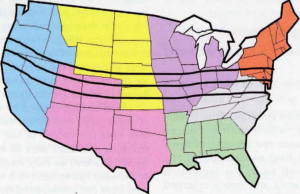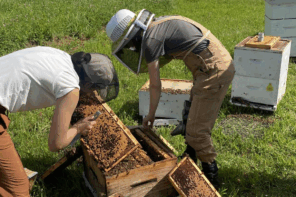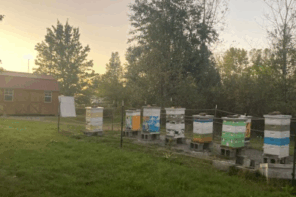By: Kim Flottum
This article originally appeared in the Autumn 2020 issue of BEEKeeping Your First Three Years
To be sure that information is relevant as to where you live, I try to time things that need to be done in the southern and northern sections of the country because temperatures, honey flows and stresses can be significantly different. Look at the map on this page that roughly divides the US as north and south. Of course, the border areas tend to be somewhat schizophrenic, some years north, some years south. So, if that’s where you live, you’ll need to pay attention to both areas, because it’ll probably be different next year. And above all else, remember that all beekeeping is local.
 In the South
In the South
Late July, early August is the key time for a lot of tasks in the beeyard, and in the bee hive. In the south, harvest is mostly complete because the majority of bloom was over by late June, with perhaps a few crops hanging on for another month or so. Food may be a problem for your bees, more so the further south you are. If you harvested from an overwintered hive, you may have to feed, and the feed you are giving is going to be winter food, to be stored, and, food for right now. Get a Spring scale, one that you can hold in one hand, with a hook on the bottom. Lift the front, lift the back, add the two weights and, for 2, 10 frame deeps, top and bottom, bees, brood and food, the total should be 150 pounds or more. If lighter first choice is honey from one of your healthy hives that has extra. Honey is always the best choice. But if not, feed a 1:1 sugar syrup in August, moving to a 2:1 in September until your weight is enough. And if you’re in a dearth, get in and out during your inspections to avoid too much exposure and starting a robbing session. First year hives are especially vulnerable now, so keep checking for food as often as you can and feed until full. And what’s the small hive beetle situation?If you’re seeing them on frame tops, inner cover and in cells you’ve got too many, not at all uncommon in the south. Get traps, yesterday. The between-frame V shaped plastic work well. And do your Varroa test by yesterday if possible. You should treat if you find more than 1 in a 300-bee wash. And you want none now because the bees that are born from now until October are the bees that overwinter, and you want them healthy, wealthy and wise. Find out what others are using for treatments and follow instructions. Besides food, check for any diseases, and how the queen is doing. There should be several frames, 6 – 10, of all stages of brood now, tapering off in late August and not having much by the end of September. Combine weak colonies if necessary, keeping the best performing queen.
In the North
In the north, there are still honey flows going on now, but check just in case. You may be able to get a short harvest now from overwintered hives, leaving enough for Winter food. If you started as a package, probably no extra honey will be available. Be generous the first season and let them have it all. But, on occasion you may have had a generous Summer flow that you can sneak some of. And consider a 3 for 1 check. You’re looking at how much honey is on the hive. If you’ve already harvested from stronger hives, you’ll need to make sure that what’s left is going to be enough. A good rule of thumb is to assume the honey flow ends tomorrow and this is all you’ll get. If it’s not enough, watch into August to see if more comes in, and feed if not. The second thing to check is the queen’s performance. Your first-year brood nest should have at least 7 or 8 frames with brood of all stages on both sides. Don’t worry if it’s close, rejoice if it’s more. Older hives should have more. But if not, queen replacement is something to consider, if you can find one.
By September, hives with under-performing queens should be combined with strong, healthy colonies, removing the queen from the smaller colony. Check for all the usual suspects when it comes to diseases, and make sure, make doubly sure to check your Varroa population. If more than 1 in a 300-bee sample, you can probably get away with a treatment right now, before the Fall flow from goldenrod. But don’t treat during the goldenrod flow. And, by all means, treat rather than harvest. Treating now means you’ll have bees next Spring. Do the Spring scale trick mentioned above and you should be at 150 pounds or more by the end of September. Feeding for Winter food, if needed can start toward the end of that month, continuing until hard Winter sets in.
For both areas, take a look at your beeyard. Weedy? Messy, with unused equipment or weeds all over, blocking entrances? Start getting it spiffed up now, so when the Winter work begins in October you have nothing in your way.









